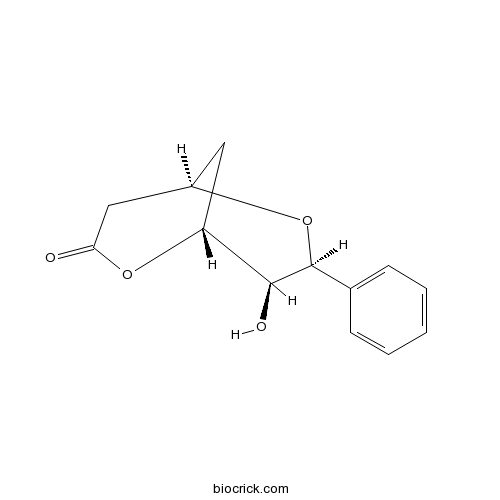9-DeoxygoniopypyroneCAS# 136685-37-5 |

Quality Control & MSDS
3D structure
Package In Stock
Number of papers citing our products

| Cas No. | 136685-37-5 | SDF | Download SDF |
| PubChem ID | 126233 | Appearance | Cryst. |
| Formula | C13H14O4 | M.Wt | 234.3 |
| Type of Compound | Phenols | Storage | Desiccate at -20°C |
| Solubility | Soluble in Chloroform,Dichloromethane,Ethyl Acetate,DMSO,Acetone,etc. | ||
| Chemical Name | (1R,3S,4S,5R)-4-hydroxy-3-phenyl-2,6-dioxabicyclo[3.3.1]nonan-7-one | ||
| SMILES | C1C2CC(=O)OC1C(C(O2)C3=CC=CC=C3)O | ||
| Standard InChIKey | ZPVLUTBGTWEMGV-AAXDQBDMSA-N | ||
| General tips | For obtaining a higher solubility , please warm the tube at 37 ℃ and shake it in the ultrasonic bath for a while.Stock solution can be stored below -20℃ for several months. We recommend that you prepare and use the solution on the same day. However, if the test schedule requires, the stock solutions can be prepared in advance, and the stock solution must be sealed and stored below -20℃. In general, the stock solution can be kept for several months. Before use, we recommend that you leave the vial at room temperature for at least an hour before opening it. |
||
| About Packaging | 1. The packaging of the product may be reversed during transportation, cause the high purity compounds to adhere to the neck or cap of the vial.Take the vail out of its packaging and shake gently until the compounds fall to the bottom of the vial. 2. For liquid products, please centrifuge at 500xg to gather the liquid to the bottom of the vial. 3. Try to avoid loss or contamination during the experiment. |
||
| Shipping Condition | Packaging according to customer requirements(5mg, 10mg, 20mg and more). Ship via FedEx, DHL, UPS, EMS or other couriers with RT, or blue ice upon request. | ||
| Description | 1. 9-Deoxygoniopypyrone shows significant cytotoxicity against human tumor cells. |

9-Deoxygoniopypyrone Dilution Calculator

9-Deoxygoniopypyrone Molarity Calculator
| 1 mg | 5 mg | 10 mg | 20 mg | 25 mg | |
| 1 mM | 4.268 mL | 21.3402 mL | 42.6803 mL | 85.3606 mL | 106.7008 mL |
| 5 mM | 0.8536 mL | 4.268 mL | 8.5361 mL | 17.0721 mL | 21.3402 mL |
| 10 mM | 0.4268 mL | 2.134 mL | 4.268 mL | 8.5361 mL | 10.6701 mL |
| 50 mM | 0.0854 mL | 0.4268 mL | 0.8536 mL | 1.7072 mL | 2.134 mL |
| 100 mM | 0.0427 mL | 0.2134 mL | 0.4268 mL | 0.8536 mL | 1.067 mL |
| * Note: If you are in the process of experiment, it's necessary to make the dilution ratios of the samples. The dilution data above is only for reference. Normally, it's can get a better solubility within lower of Concentrations. | |||||

Calcutta University

University of Minnesota

University of Maryland School of Medicine

University of Illinois at Chicago

The Ohio State University

University of Zurich

Harvard University

Colorado State University

Auburn University

Yale University

Worcester Polytechnic Institute

Washington State University

Stanford University

University of Leipzig

Universidade da Beira Interior

The Institute of Cancer Research

Heidelberg University

University of Amsterdam

University of Auckland

TsingHua University

The University of Michigan

Miami University

DRURY University

Jilin University

Fudan University

Wuhan University

Sun Yat-sen University

Universite de Paris

Deemed University

Auckland University

The University of Tokyo

Korea University
- PD 123319 ditrifluoroacetate
Catalog No.:BCC1841
CAS No.:136676-91-0
- MK-0591
Catalog No.:BCC1753
CAS No.:136668-42-3
- Timosaponin BII
Catalog No.:BCN4998
CAS No.:136656-07-0
- UK 78282 hydrochloride
Catalog No.:BCC7784
CAS No.:136647-02-4
- Calpain Inhibitor II, ALLM
Catalog No.:BCC1234
CAS No.:136632-32-1
- Senexin A
Catalog No.:BCC7980
CAS No.:1366002-50-7
- Fmoc-Tyr(3-NO2)-OH
Catalog No.:BCC3280
CAS No.:136590-09-5
- Spermine NONOate
Catalog No.:BCC6950
CAS No.:136587-13-8
- Irinotecan HCl Trihydrate
Catalog No.:BCC5091
CAS No.:136572-09-3
- Curdione
Catalog No.:BCN5936
CAS No.:13657-68-6
- Anemarsaponin E
Catalog No.:BCN6290
CAS No.:136565-73-6
- Fmoc-D-Trp-OPfp
Catalog No.:BCC3560
CAS No.:136554-94-4
- NB-598 hydrochloride
Catalog No.:BCC1787
CAS No.:136719-25-0
- 2-Mercaptoethanesulfonic acid
Catalog No.:BCC1789
CAS No.:3375-50-6
- Minimolide F
Catalog No.:BCN6424
CAS No.:1367351-41-4
- 4,4'-Bismaleimidodiphenylmethane
Catalog No.:BCC8662
CAS No.:13676-54-5
- Gallic aldehyde
Catalog No.:BCN7859
CAS No.:13677-79-7
- Retinyl glucoside
Catalog No.:BCC1891
CAS No.:136778-12-6
- Goniodiol diacetate
Catalog No.:BCN3956
CAS No.:136778-40-0
- Lubiprostone
Catalog No.:BCC4918
CAS No.:136790-76-6
- [Ser25] Protein Kinase C (19-31)
Catalog No.:BCC1022
CAS No.:136795-05-6
- 6-O-Cinnamoylcatalpol
Catalog No.:BCN6193
CAS No.:136807-41-5
- Delavirdine
Catalog No.:BCC4300
CAS No.:136817-59-9
- 1-Dehydro-10-gingerdione
Catalog No.:BCN3338
CAS No.:136826-50-1
Two new styryl lactones, 9-deoxygoniopypyrone and 7-epi-goniofufurone, from Goniothalamus giganteus.[Pubmed:1791471]
J Nat Prod. 1991 Jul-Aug;54(4):1034-43.
Two new styryl lactones, 9-Deoxygoniopypyrone [1] and 7-epi-goniofufurone [3], and a known styryl lactone, goniodiol [5], were isolated from the stem bark of Goniothalamus giganteus. The structures were elucidated by ir, ms, 1H-nmr, 13C-nmr, and 1H-1H COSY spectra; the relative configurations were determined by X-ray crystallographic analysis. Unlike goniopypyrone [2] and goniofufurone [4], neither of the new styryl lactones 1 and 3 showed significant bioactivities to human tumor cells. However, goniodiol [5] showed significant and selective cytotoxicity against human lung tumor cells (A-549).
Cytotoxic and antioxidant compounds from the stem bark of Goniothalamus tapisoides Mat Salleh.[Pubmed:23344192]
Molecules. 2012 Dec 21;18(1):128-39.
Eleven compounds:goniomicin A (1), goniomicin B (2), goniomicin C (3), goniomicin D (4), tapisoidin (5), goniothalamin (6), 9-Deoxygoniopypyrone (7), pterodondiol (8), liriodenine (9), benzamide (10) and cinnamic acid (11), were isolated from the stem bark of Goniothalamus tapisoides. All compounds were identified by spectroscopic analysis and, for known compounds, by comparison with published data. Goniothalamin (6) exhibited mild cytotoxic activity towards a colon cancer cell line (HT-29), with an IC(50)value of 64.17 +/- 5.60 microM. Goniomicin B (2) give the highest antioxidant activity in the DPPH assay among all compounds tested, with an IC(50) of 0.207 microM.


